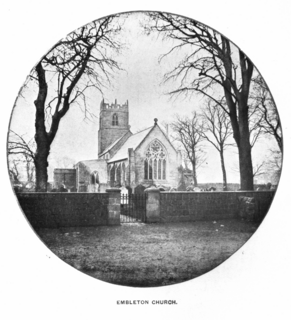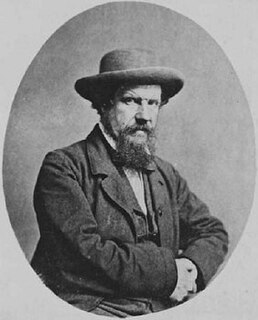
Northumberland is a county in Northern England, one of two counties in England which border with Scotland. Notable landmarks in the county include Alnwick Castle, Bamburgh Castle, Hadrian's Wall and Hexham Abbey.

William Wouldhave (1751–1821) is a rival of Lionel Lukin for recognition as inventor of the lifeboat. His tombstone describes him as:

Berwick-upon-Tweed is a parliamentary constituency in Northumberland represented in the House of Commons of the UK Parliament since 2015 by Anne-Marie Trevelyan, a Conservative.

Bolton is a small village and former civil parish, now in the parish of Hedgeley, in the county of Northumberland, England. It is situated on the north side of the River Aln, about two miles (3 km) east by north from Whittingham, and 5+1⁄2 miles west from Alnwick. It has a chapel and a small number of residential properties.
This timeline summarises significant events in the history of Northumbria and Northumberland.
This is a list of the High Sheriffs of the English county of Northumberland. The High Sheriff is the oldest secular office under the Crown. Formerly the High Sheriff was the principal law enforcement officer in the county but over the centuries most of the responsibilities associated with the post have been transferred elsewhere or are now defunct, so that its functions are now largely ceremonial. The High Sheriff changes every March.

Lilburn Tower is a privately owned 19th-century mansion house at Lilburn, near Wooler, Northumberland. The property is a Grade II* listed building and forms part of the Lilburn Estate. A number of discrete buildings and monuments are scattered across the grange, including the Hurlestone, Hurlestone Tower and an astronomical observatory.
John and Benjamin Green were a father and son who worked in partnership as architects in North East England during the early nineteenth century. John, the father was a civil engineer as well as an architect. Although they did carry out some commissions separately, they were given joint credit for many of their projects, and it is difficult to attribute much of their work to a single individual. In general, John Green worked on civil engineering projects, such as road and rail bridges, whereas Benjamin worked on projects that were more purely architectural. Their work was predominantly church and railway architecture, with a sprinkling of public buildings that includes their masterpiece, Newcastle's Theatre Royal.

The Church of the Holy Trinity is located in Embleton, Northumberland, England. The church, dedicated to the Holy Trinity, is west of the village. Built in the form of a cross, it consists of a two aisle nave, a clerestory, a chancel, a porch, and a chantry chapel. It has a tower with a small vestry, and a gallery. The vicarage house and garden are on a gradual slope on the south side of the churchyard. Traces of stonework show evidence of an earlier church from the 12th century. It is a Grade I listed building.
Philip Bickerstaffe (1639–1714) was an English merchant and the owner of Amble Works. He was M.P. for Berwick-upon-Tweed 1685; and for Northumberland 1689-1698. He descended from the family of Bickerstaffes, of Bickerstaffe, Lancashire. Although he opposed the transfer of the Crown to the Prince of Orange in 1668-9, he was re-elected for the next parliament of 1669-90. He was known to be "a courtier of the Widdrington group but an unimpeachable Anglican" and a Clerk of His Majesty's Woodyard from about January 1669. Bickerstaffe was a free burgess of Newcastle, a member of one of the twelve mysteries of the same town, and was admitted to his personal freedom of the fellowship of Hostmen on 11 September 1684.
John Clarke was an English landowner and politician who sat in the House of Commons from 1670 to 1675.
Thomas Houston, although born in Ireland, was considered a Tyneside poet/songwriter.
W & T Fordyce was a nineteenth century firm of publishers based in the early years at 48 Dean Street, Newcastle upon Tyne, which later moved to 15 Grey Street, Newcastle. It was responsible for the editing, publishing, printing selling of the book The Tyne Songster.

The Reverend John Collingwood Bruce, FSA was an English nonconformist minister and schoolmaster, known as a historian of Tyneside and author. He co-operated with John Stokoe in compiling the major song collection Northumbrian Minstrelsy published in 1882
James Robson was a Northumbrian landowner, poet, songwriter, "political criminal" and one time Jacobite rebel.

Robert Benson Bowman was a Newcastle bookseller and entrepreneur. As well as publishing a range of popular books, Bowman was a business partner of the ironmaster Lowthian Bell and an amateur botanist.
Thomas Hanway Bigge was an English banker in Newcastle upon Tyne. The Bigge family were gentry based at Longbenton in the later 18th century, and are well documented; but Thomas Hanway Bigge has been confused with another member of the family, Thomas Bigge (1766–1851), who had moved to the London area by about 1810.
William Bigge (1707–1758) was an English lawyer, landowner and colliery owner.
Colonel George Liddell (1678–1740), of Eslington Park, Northumberland, was a British coal owner and Whig politician who sat in the House of Commons from 1727 to 1740. He was one of the dominant figures in the coal-business in the North East, and was a colonel in the militia who was active against the Jacobite threat.








